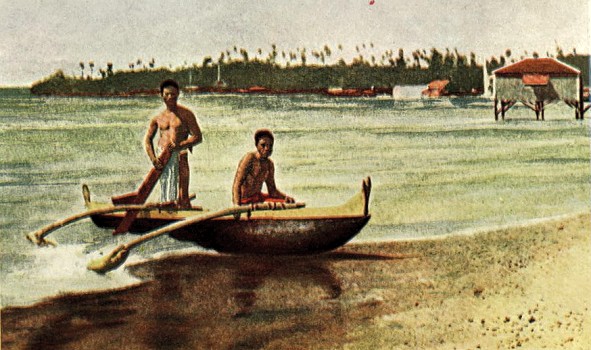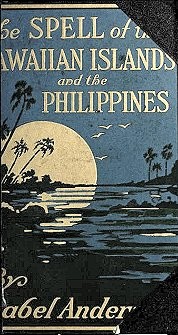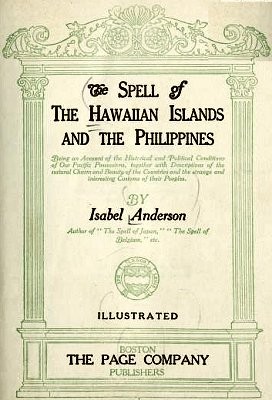surfresearch.com.au
 |
surfresearch.com.au
isabel
anderson : surf riding in hawai'i, 1916.
|
Isabel
Anderson : Surf riding in Hawai'i, 1916.
Extracts and colour photograph from
Anderson, Isabel
The Spell of the Hawaiian Islands and the
Phillippines;
being an account of the historical
and political conditions of our Pacific possessions,
together with descriptions of the
natural charm and beauty of the countries
and the strange and interesting
customs of their peoples.
The Page Company,
Boston, 1916
Internet Archive
http://archive.org/details/spellofhawaiiani00ander
Introduction.
Wa
Page 5
As we approached the dock, we forgot to watch the
frolicking porpoises and the silver flying fish, at sight of
the daring natives on their boards riding the surf that broke
over the coral reef.
The only familiar face we saw on
the wharf as we landed was Mr. George Carter, a friend of my
husband's, who has since been
Governor of the Islands.
Facing page 16

[Surf-boating]
Page 16
After lunching with the
American Minister, Mr. Sewall, one day, we sat on his lanai at
Page 17
Waikiki and watched the
surf-boating, which was most exciting, even from a distance, as
the canoes came in at racehorse speed on the crest of the
breakers.
That day L. and I put
our bathing suits on, as we did indeed several times, got into
an outrigger canoe with two native boys to handle it, and
started for the reef.
They skilfully paddled
the boat out between the broken waves, waiting for the chance to
move on without meeting a foaming crester, and then hurrying to
catch a smooth place.
At last we got out far
enough and turned, watching over our shoulders for a big fellow
to come rolling in.
Then the boys paddled
wildly and allowed the crest, as it broke, to catch and lift the
boat and rush it along on top of the roaring foam, right up to
the beach.
On one of our trips our
oarsmen were a little careless and we were upset.
But instead of swimming
in shore we swam out to sea and pushed the boat until we were
well beyond the breakers, where we could right it again and get
in — which, for those not used to it, is not a particularly easy
thing to accomplish.
The people on the shore
became frightened about us and sent out another boat to pick us
up, for we were quite far out and there were many sharks around.
By the way, one hears it
questioned even to-
Page 18
day whether sharks really do eat men, notwithstanding two men
were bitten lately while bathing as far north as on the New
Jersey coast.
I will simply say I have
seen a black diving boy at Aden with only one leg, as the other
was bitten off by a shark, and have myself even worn black
stockings when bathing in tropical seas because it is said
sharks prefer white legs to black.
Page 32 [Myths and
Meles]
Boxing, surf-riding and
hurling the ulu — a circular stone disk, three or four inches in
diameter — were some of the favourite amusements, as well as
tobogganing, which is interest- ing as a tropical adaptation of
something that we consider a Northern sport.
The slide was laid out
on a steep hillside, that was made slip-
Page 33
pery with dry pili grass.
The sled, of two long,
narrow strips of wood joined together by wicker work, was on
runners from twelve to fourteen feet long, and was more like our
sleds than modern toboggans.
The native held the sled
by the middle with both hands, and ran to get a start.
Then, throwing himself
face downward, he flew down the hill out upon the plain beyond,
sometimes to a distance of half a mile or more.
Page 91
The Hawaiians also plant
taro for poi, which, although now manufactured by machinery, is
still their favourite food, and is also eaten by the whites:
Doctors pronounce it most digestible and strengthening.
Duke Kahanamoku, a
native who has always lived on poi, is the champion swimmer of
the world.
It is true that not only
poi but also the climate is favourable to our race as well, for
white boys brought up in Hawaii have proved themselves to be
strong, all those who have gone into athletics in American
colleges having made fine records.
Page 115
On the shore , at the
extreme western point of the island [Kaui], are the Barking Sands, a row of sand dunes.
"The wind on the sands
makes them rustle like silk; to slide down them produces a sound
like thunder; to stamp on them makes them cry out in different
cadences."
Not far away is an old
bathing beach, where a bath was supposed to bring good luck.

surfresearch.com.au
Geoff Cater (2013-2018) :
Isabel Anderson : Surf Riding, Hawaii, 1916.
http://www.surfresearch.com.au/1916_Anderson_Spell_Hawaii_Phillipines.html





